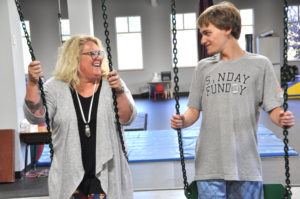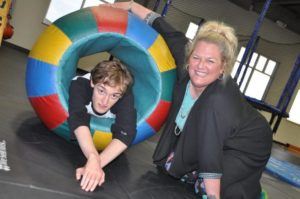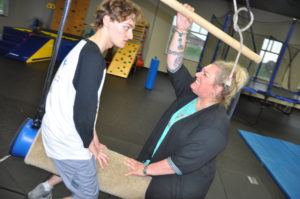Jenn Jordan
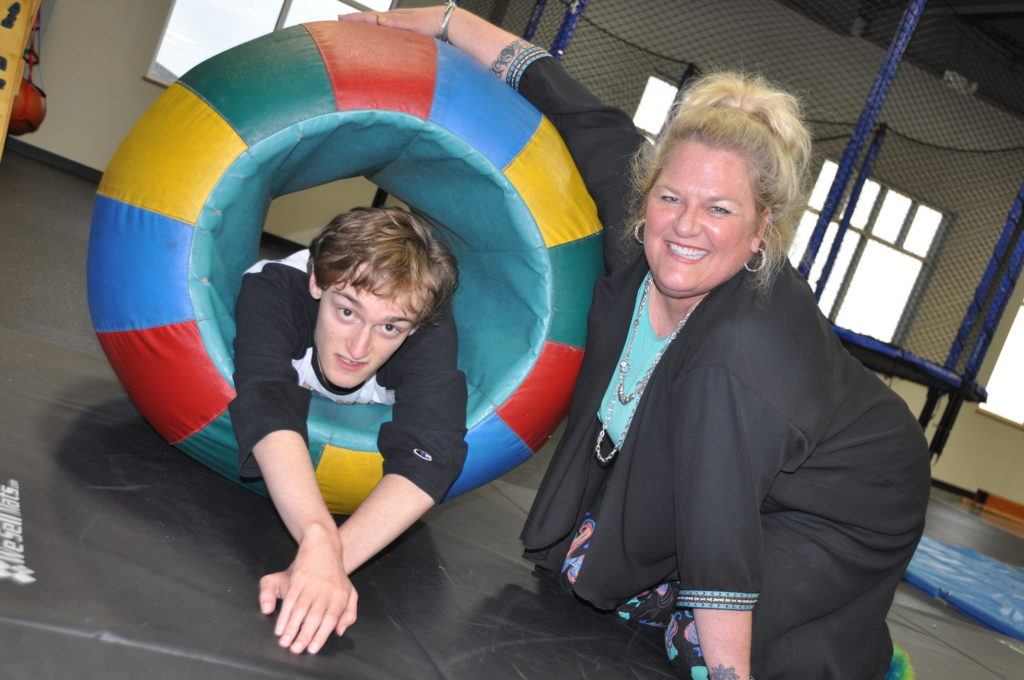 Jakob was diagnosed when he was 3 and a half. It wasn’t a surprise, I had suspected it since he was 9 months old. This was 14 years ago this month and back then, doctors were hesitant to diagnose before the age of three. So for almost 2 years, all we heard was that he had sensory processing disorder. He was receiving a little bit of treatment for that but nowhere near what we would have done if someone would have just told us that he had autism.
Jakob was diagnosed when he was 3 and a half. It wasn’t a surprise, I had suspected it since he was 9 months old. This was 14 years ago this month and back then, doctors were hesitant to diagnose before the age of three. So for almost 2 years, all we heard was that he had sensory processing disorder. He was receiving a little bit of treatment for that but nowhere near what we would have done if someone would have just told us that he had autism.
It was frustrating and it honestly felt a bit cruel. I knew something was wrong, we needed and wanted help. The constant delaying of the inevitable gave me false hope. It also made me feel like I was crazy and paranoid and maybe had some psychological issues of my own if I was so sure that there was something wrong with my kid. It was such a scary and stressful time. When the diagnosis finally came, it was terrifying. And it was also a relief. We finally knew what we were dealing with. Well, sort of. We didn’t know how this diagnosis would present itself in Jakob. We didn’t know what kind of road we had ahead of us. We didn’t know anything new really. But we had a label.
I can remember asking the doctor, “Will he ever speak? Will he ever look at us? Will he have friends, go to school, play sports? Will he be able to live on his own or have a job? Will he ever hug me or tell me he loves me? Will he ever even care that I’m in the same room with him?” The answer to all of my questions was the same. The doctor said, “I don’t know.”
At that point, they told me that OT, Speech and Physical Therapy would probably help. They said that there was one behavioral treatment that was showing some promise in decreasing negative behaviors. And that was it. We were told that autism was a “lifelong disability with no cure” and they didn’t know how he got it. We left the hospital with a folder that had a couple flyers and phone numbers in it but no real plan. No clue what to do next.
Dazed, confused, scared, helpless, hopeless and lost. For starts. More emotions than I could count. So many questions. Where to go? What to do? Who to call? How to explain this? How to pay for it? What does our future hold? Where will I find to time and energy to fix this? Can it be fixed? Why is this happening? What did I do wrong that caused this? Will I ever be able to survive this? For starts. More questions than I could count and far too overwhelming in the beginning to find any answers.
It took years before I really felt like I was figuring anything out. It took me that long to find the strength and confidence that I needed to really know that no one knew Jakob better than I did. And to realize that whatever it was that was out there to help him, it was up to me to find it. And that’s when our journey truly began.
Diagnosis day seems so long ago. So much has changed and Jakob has come so far. Aside from an occasional flash of fear or moment of sadness, I’m good. Actually, I’m better than good. I’m great. And Jakob is an amazing, fun-loving kid who speaks, has friends, goes to school, plays sports, hugs me, loves to hang out with me and says “I love you, mom.”
Life with an autism diagnosis has turned out to be pretty awesome. The experiences I’ve had with Jakob have been so rich, so meaningful. My relationship with him is the sweetest and most tender relationship I’ve ever had. The love is so pure. As is his heart.
Time and lots of love and acceptance brings clarity. And I am clear, Jakob and his autism are a gift. The best one I’ve ever received.
Read More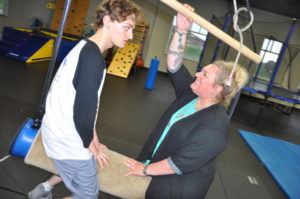 When Jakob was little and the diagnosis was new, the fear was so great that the anxiety, depression and the mere fight to survive was overwhelming. There was love there, so much love, it just felt so out of reach from the pain and suffering of the moment. Thankfully, time changes things. The distance from the most stressful of days has gifted me with clarity. In that clarity, I have found so much beauty. I am now so grateful for the special brand of love Jakob’s autism has brought into my life.
When Jakob was little and the diagnosis was new, the fear was so great that the anxiety, depression and the mere fight to survive was overwhelming. There was love there, so much love, it just felt so out of reach from the pain and suffering of the moment. Thankfully, time changes things. The distance from the most stressful of days has gifted me with clarity. In that clarity, I have found so much beauty. I am now so grateful for the special brand of love Jakob’s autism has brought into my life.
I have a 17-year-old son who will on a regular basis walk beside me and hold my hand through Kroger. Standing at the checkout, he’ll lovingly rest his head on my shoulder. How many typical 17-year-olds do that? Since I never know which time may be his last, I always soak it in, never taking his sweet and tender gesture for granted.
During just normal conversation, he will stand in front of me, look me in the eye, grab both my hands and smile at me. Sometimes he’s talking about stuff that’s a big deal like having to go to study hall. But most often it’s about the simple stuff, like having waffles for dinner. The love in his eyes and the desire to connect melts my heart every time.
We have our own language. We can communicate with each other clearly and concisely while others watch and listen and have no clue what’s going on. He knows that I will always listen and if I don’t understand what he’s trying to tell me, he knows I will keep trying until I figure it out. I love being his safe place and the person he can always talk to about anything.
Recently, he accidentally shaved off his sideburns and that was the funniest thing that happened the entire day. I showed him where hair is supposed to grow on his face and where he needs to stop the razor. It turned into a laughfest that included pictures and texts to family and friends saying “I shaved off my sideburns. Whoopsies”. There’s so much joy in the silly little things.
I think we’ve both learned that everything is little and it’s all silly. Laughter lives large in our home. Being able to laugh at everything has proven to be the best medicine for a kid who struggles to figure out how the world most people live in works and a mom who so desperately wants to help him do that.
Yes, he has taught me patience, compassion, tolerance, kindness, acceptance, perseverance. He has also shown me how to bravely be who I am. This he does by example every day. I have a child who will not conform to what society thinks he should be. How he should think and see and talk and act and be. Jakob is Jakob and he will dig his heels in and fight anyone who forcibly tries to make him be something he’s not. That takes courage and conviction. An incredible example for us all.
Jakob is such a blessing. Every day. He’s my best friend, my teacher, my buddy, my favorite Friday night date, my co-pilot, my navigator, my partner in crime, my joy, my heart, my soulmate, my son. We couldn’t be any more perfect than that.
Read More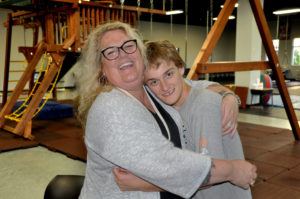 Jakob has always been a picky eater. For years, he would only eat four foods. Hot dogs, apple-cinnamon protein cereal, bananas and smoothies. Always a specific brand and flavor and he would never deviate. He’d smell his hot dogs every time just to make sure they were the right ones. I tried once to give him the same brand of hot dogs but they were organic instead of just antibiotic-free. He gave them a sniff and then refused to eat them. He was not happy with me that day.
Jakob has always been a picky eater. For years, he would only eat four foods. Hot dogs, apple-cinnamon protein cereal, bananas and smoothies. Always a specific brand and flavor and he would never deviate. He’d smell his hot dogs every time just to make sure they were the right ones. I tried once to give him the same brand of hot dogs but they were organic instead of just antibiotic-free. He gave them a sniff and then refused to eat them. He was not happy with me that day.
I couldn’t understand why he was being so stubborn. I mean, come on, who doesn’t want to eat cake? So I would try to be sneaky. I’d walk up behind him and smudge frosting on his lips, convinced that he’d love it if he would just taste it. Bad idea. He’d scream and gag and wipe his mouth. He’d be so upset. In hindsight, what I was doing was so rude and disrespectful. And I’m sure it had a negative effect on his trust in me. I’m so sorry about that, buddy.
What I didn’t realize at the time was eating and eliminating food were truly the only two things that kiddos on the spectrum have ultimate control over. In a world that they find so overwhelming and unpredictable where everything is out of their control, what can they do to feel like they have any say-so at all in their lives? Choose what goes in their mouths and when and where (bathroom, diaper, floor, on the bed) it comes out. I know of children who refuse to poop at all and it’s a big problem.
So before I even thought about attempting to add foods to his diet, I had to get him to loosen his grip on control with foods. To accomplish that, I started to give him more control in other places and I let him make some decisions. Which way do you want to go to Target, Tylersville or Liberty Way? Do you want to wear the black sweatpants or the grey ones? What do you want to do first, wash your face or brush your teeth?
In letting him choose, it became evident that in order for him to relax his need to control, I had to relax mine. Did it really matter to me which way we went to Target? No. But it mattered to Jakob.
After months of me letting go and him loving his newfound freedom and power, I began to consider approaching the new foods thing. The biggest obstacle was his limited ability to communicate. He couldn’t explain any of it to me, still can’t. I didn’t know how food was affecting him. Did it hurt his belly? Give him gas? Cause any pain at all? No clue. But I knew he suffered from occasional reflux and constipation. And he obviously was sensitive to smell so I made the assumption that his other senses involved with eating were heightened too. Touch, sight, taste and even hearing. The textures of the foods in his fingers, on his tongue, in his mouth. Maybe the colors or shapes of foods were appealing or unappealing to him. I had to consider flavors and whether food was sweet or savory or spicy. And I had to think about the sounds the food was making in his head as he chewed. Eating something crunchy makes a very different noise than sucking something though a straw. A lot to consider.
I decided to start with foods that were similar to what he was already eating. I started with chicken hot dogs (he already ate beef) and crackers (crunchy like cereal). I approached him with a calendar (which he loved) and I gave him a bunch of foods to choose from. He’d pick the foods and then the dates and times he would eat the new foods. We’d write it down on the calendar and when the day came, he would eat it. Eventually we added more foods and he’d take at least one bite (number of bites was also negotiable).
With every new food, he would look at it for a long time. He’d smell it, touch it, move it around with his fork. And as soon as he’d put it in his mouth, he’d gag. Every time. It wasn’t easy for him and he didn’t like everything. But he would try it and I would celebrate his efforts like he’d just won a gold medal at the Olympics. In our world, he had.
Jakob trying new foods was a little bit about food and a whole lot about my beliefs about why he was so picky and stubborn. He wasn’t the one who was being stubborn and picky, I was. And once I figured that out, it was easy as cake.
Read More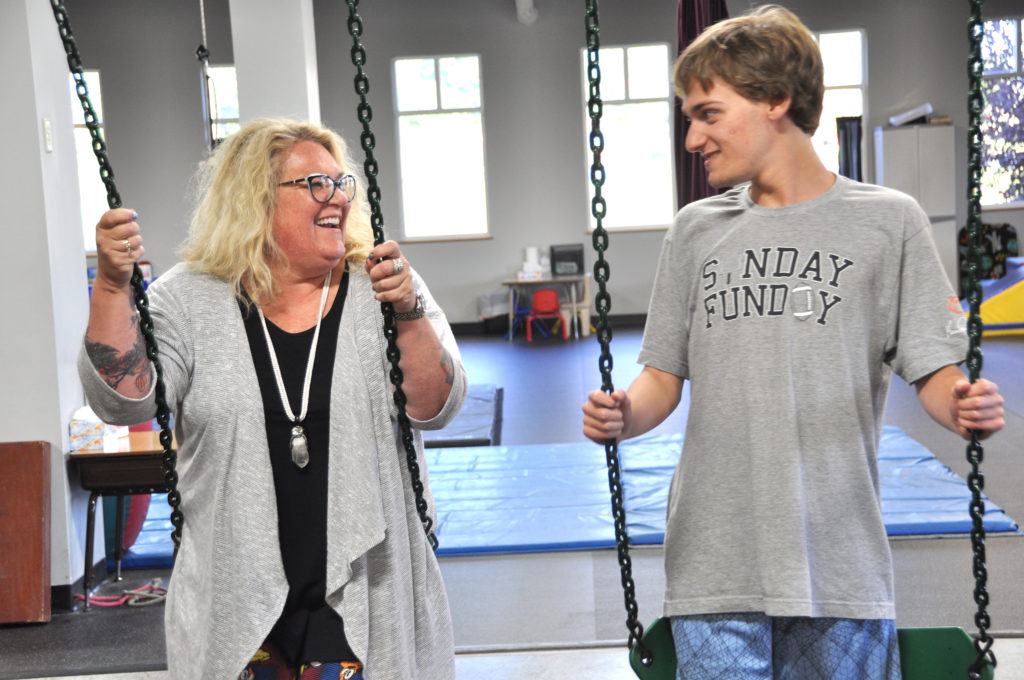 At Jakob’s first IEP meeting when he was three, his teacher asked me what goals I had for him. I had no clue. I mean I knew I wanted him to be better. To be happier. To act more like other kids his age, you know, the “normal” ones. Seeing the end results I wanted was easy. Creating a plan for how to get there was not. In that initial meeting while I sat in a chair made for a toddler, the only goal I could come up with was “drink out of a cup.”
At Jakob’s first IEP meeting when he was three, his teacher asked me what goals I had for him. I had no clue. I mean I knew I wanted him to be better. To be happier. To act more like other kids his age, you know, the “normal” ones. Seeing the end results I wanted was easy. Creating a plan for how to get there was not. In that initial meeting while I sat in a chair made for a toddler, the only goal I could come up with was “drink out of a cup.”
After fourteen years of practice and lots of work to understand, it’s easier. I can look at Jakob and see where he is and where I’d love to see him go next. A lot of the time, I even know what we can do to help get him there. Back then the process was frustrating and scary, now it’s exciting and fun.
The biggest struggle for me in the beginning was coming to the realization that accepting where he was didn’t mean that I believed he wasn’t capable of doing or being more. Acceptance doesn’t mean losing faith or giving up hope. It means seeing without judgment what is right in front of me. And the only way to make a plan for where I wanted us to go was to really understand where we were. Once I got a good handle on that, we were ready to proceed.
The other big shift in my thinking had to do with expectations and attaching to outcomes. After learning to accept that Jakob was right where he was with communication and eye contact and flexibility and behaviors, I also had to accept that nothing may ever change. Where he was in each of those moments that he didn’t seem to notice I was in the same room or when he would scream and cry for reasons that weren’t apparent to me, may be exactly where he was going to stay forever. I had no way of knowing. Just because I wanted him to learn new things and that there would be a whole team of people trying to teach him those things didn’t mean he was going to learn them. I remained hopeful, with no expectations. And if I was to do all of that with an open and loving heart, I had to be ok if nothing did change. I had to do all of the goal setting and planning and teaching with no attachment to the outcome. If he learned something new, great! If nothing changed, great! Either way, I would continue to love and not judge and accept. And I would keep trying.
I think it’s really easy to get all caught up in the “should-be” thinking with our special kids. So much so that we miss the possible what-may-be’s. He should be looking in my eyes (maybe it’s hard for him to listen to what I’m saying if he has to look at me too). He should be eating more vegetables (maybe they’re hurting his stomach and he just can’t tell me). He should be riding a bicycle (maybe his whole world spins when his feet leave the ground and he gets terrible vertigo). When we put “should-be” pressure on ourselves and them, we all suffer.
Accept where your child is. Don’t judge them (or you) if they don’t change. And love love love them no matter what. If you’re able to do that, it’s easy to set goals and you’ll have so much fun helping them reach them. Or not reach them. Either way, you’re living a life filled with unconditional love.
Read More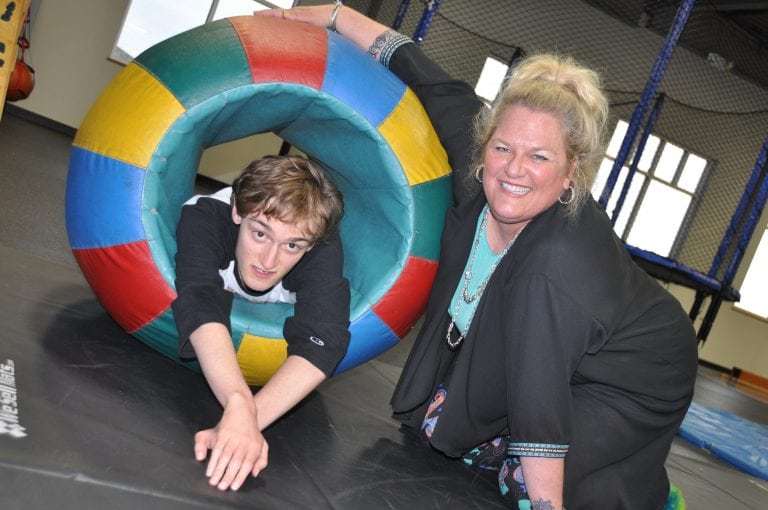 When Jakob was little, he seemed so disconnected. I never knew if he was listening to anything I was saying. I didn’t know if he even knew his own name. He rarely showed any interest in anything I was doing or wanted to do with him. I tried reading books, building blocks, singing the ABC’s. His only interests were jumping on his trampoline, watching his favorite DVD’s (Baby Einstein, Sesame Street and Signing Time,) and playing with all his battery operated toys. He could go hours without even acknowledging I was in the room. I wasn’t sure if he had any interest in a relationship with me that involved interaction, affection, and communication or if he just didn’t know how to connect.
When Jakob was little, he seemed so disconnected. I never knew if he was listening to anything I was saying. I didn’t know if he even knew his own name. He rarely showed any interest in anything I was doing or wanted to do with him. I tried reading books, building blocks, singing the ABC’s. His only interests were jumping on his trampoline, watching his favorite DVD’s (Baby Einstein, Sesame Street and Signing Time,) and playing with all his battery operated toys. He could go hours without even acknowledging I was in the room. I wasn’t sure if he had any interest in a relationship with me that involved interaction, affection, and communication or if he just didn’t know how to connect.
The only thing that was apparent was he had quite the wonderful relationship with electronics. They entertained him and made him smile. I would find myself a little jealous of Elmo and Big Bird. I wanted my son to look at me with that same gleam in his eye and to laugh at the things I was doing and saying. I had to remind myself to be glad that he was having fun but I was so very sad that it wasn’t with me.
I spent years thinking that I was destined to forever have a kid who wanted nothing to do with me. He would come to me to be fed but that was it. Then one day while I was watching him giggle hysterically at something Cookie Monster said, I had a realization. I could never compete with all that. The toys and videos had mesmerizing sights and sounds and sound effects and characters. They were irresistible. They were far more interesting than anything I could do. As long as they remained in his world as options, I would always lose. So one day when he was out of the house, I gave it all away.
It was a tough decision. I was taking away all the things he loved most. The things that made him the happiest. The only things in his life that made him laugh. But I knew that if I was going to reach him and inspire him to want to be, really be, with people, it all had to go. And I also knew that I would have to sit with the confused and sad tears while he mourned the loss. While I comforted, I knew I had to reassure him in a positive and enthusiastic way that we were going to have so much fun together. And I immediately sprung into action showing him exactly how we were going to do just that.
I took some of his favorite things from the videos and games and turned myself into them. I was a sound effect machine that would make different noises when he poked me in the arm or touched my nose. I was Super Grover stumbling awkwardly all over the place. (He loved slapstick humor so I fell down a lot.) I had puppets and stuffed animals of some of his favorite characters and they did all sorts of silly things. At first he couldn’t quite figure out what I was doing but he eventually caught on. And when he did, he thought it was a hoot. There was endless material for me to have fun with and it didn’t take long before my wish came true. My Jakob was looking at me with that Sesame Street gleam in his eye and he was laughing right along with me. It was a beautiful thing.
After a few years, Jakob got an iPad and he found a couple games he liked. He would play a little bit here and there but would always put it down when he wanted to play with me. There was never a fight about it. Time passed and he played with it less and less. He eventually decided he was done and he deleted all his games and put his iPad away. He has an iPod now that he uses to send text messages and emails on occasion. But it’s used mostly to check out traffic issues, route our trips and figure out detours when roadwork is necessary.
I’m so glad I made that tough decision when I did. I think it saved us both from an addiction that would have done us harm. And it undeniably helped create a bond that no muppet or screen can ever break.
Read More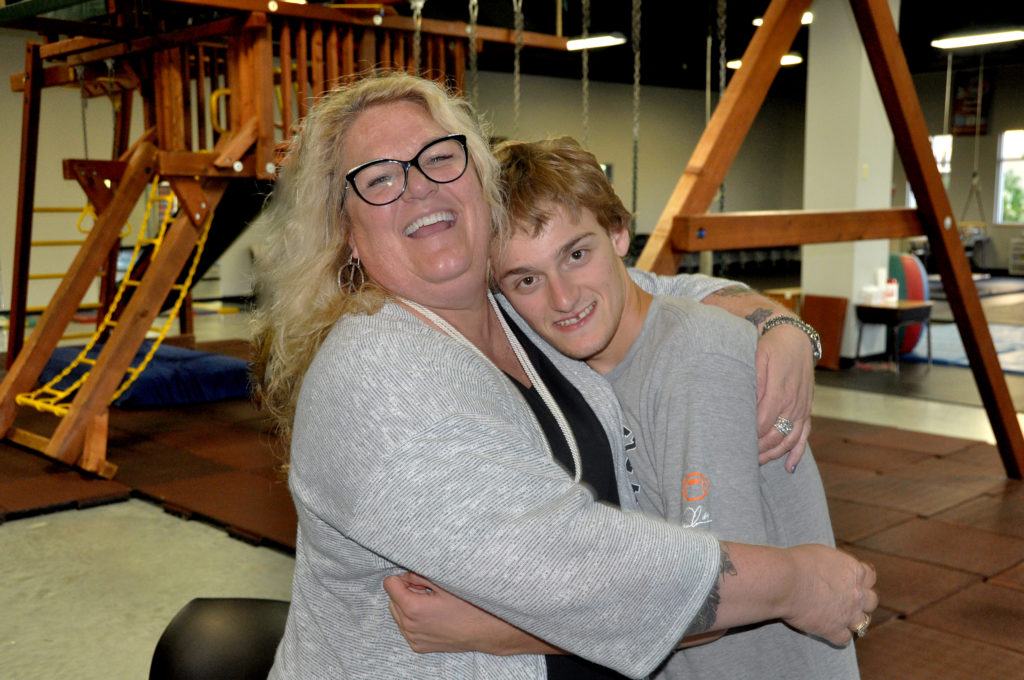 The first time Jakob had to have blood drawn, it took three of us to hold him down. He kicked, he screamed, and he fought to get free. It was a traumatizing event for both of us. It felt so very wrong and the guilt was immediate, deep and torturous. He didn’t understand what we were doing or why. I’ll never forget the look of betrayal, confusion, and the loss of trust in his eyes. It was my job to keep him safe and out of harm’s way and in that moment, I was failing. I wasn’t just failing; I was the one inflicting the pain. I couldn’t help but believe there was a different way.
The first time Jakob had to have blood drawn, it took three of us to hold him down. He kicked, he screamed, and he fought to get free. It was a traumatizing event for both of us. It felt so very wrong and the guilt was immediate, deep and torturous. He didn’t understand what we were doing or why. I’ll never forget the look of betrayal, confusion, and the loss of trust in his eyes. It was my job to keep him safe and out of harm’s way and in that moment, I was failing. I wasn’t just failing; I was the one inflicting the pain. I couldn’t help but believe there was a different way.
In my never-ending journey to find answers and more kind and gentle ways to handle everything that comes with autism, I came across some philosophies that really resonated with me. What I model, I teach. Pain is unavoidable, but suffering is optional. Everything in life is as much fun as we make it.
The approach that I had taken on all lab experiences up to that point consisted of me putting him in the car, not talking at all about where we were going or what we were doing, taking him into a sterile room and pinning him down. I believed before we even got there that it was going to be awful, horrible and extremely painful. That was the problem. So I made the conscious decision that to no longer subscribe to that belief and that I would never jeopardize our connection, his trust in our relationship or me like that again.
About a week before Jakob’s next trip to the lab at Children’s Hospital, I got myself calm, cool, collected, and excited about how I was going to approach the whole experience. We were in his playroom, the place, and space that was designed to be “Jakob’s World.” In that room, we always did what he wanted to do in the way he wanted to do it. We played his games and we talked about what he wanted to talk about. My job was to love him, accept him, not judge him and do all of this with energy, excitement, and enthusiasm.
The trick to teaching him something new in that environment (and all environments, really) was to wait until the timing was right and then introduce the new game, idea, or experience in a way that he would enjoy. Jakob loved step-by-step, numbered lists. So when my moment came, I told him that we were going for a “quick pinch” on Saturday morning. Then I “quick-pinched” him all over like I was playing a tickle game. He thought that was pretty funny. Then I walked him through the process, modeling for him on myself what was going to happen in a very silly, animated, excited, dramatic way.
1. You’re going to stick your arm straight out. (I stuck my arm out while he watched.)
2. Then a quick pinch right here! (Squeezed the skin where the needle would go.)
3. Then we’ll countdown…10, 9, 8, 7, 6, 5, 4 etc.
4. And when we get to 0, “Boom!” The quick pinch is done!
5. Then we put on a Band-Aid (which he also loved.)
6. And we wrapped it up with a celebratory dance. “Yay! Awesome!! Good job!”
I did it all with so much of the type of enthusiasm that he loved and incorporated things that motivated him. He bought in and before I knew it, we were playing the game over and over again with his arm. He was totally into it. We ended up making one small change to the routine. Instead of counting down with numbers (effective but kind of dull,) we sang a song. As we sang the last note of the song, the needle would come out and the Band-Aid would go on. His song of choice was “Hark! The Herald Angels Sing.” It was perfect.
With a solid attitude on both our parts that this trip would be fun and that quick pinches were no big deal, we had a completely smooth and trauma-free experience. In the one brief moment when he glanced at me with a tinge of uncertainty, I remained solid and confident. That was all it took to keep him at ease and ready to sing. As it turned out, there were a few phlebotomists over the years who liked to belt out a chorus or two of one of the greatest Christmas carols of all time right along with us.
While we no longer sing or go through the theatrics of it all, we still have easy trips to the lab. He’s always excited to go and he’s always happy when we leave. I’m so grateful that we figured it all out and that his trust in me has remained intact.
It was such a powerful lesson that proved all three philosophies I mentioned earlier true. Now when we’re trying something new, I ask myself, “How do I want him to think, feel and act in this situation? Is that the way I’m thinking, feeling and acting right now?”
Because is it fair to ask him to do anything that I’m not willing to do myself? How can I teach him to be calm if I’m freaking out? How can I teach him to be happy if I’m mad? How can I expect him to be relaxed if I’m all tense? I can’t.
What I model, I teach. No matter where we’ve been or what we’ve done, it’s always my attitude that leads the way. Sometimes it may take more than one or two tries, but my sweet, trusting, fun-loving boy always ends up following.
Read More Jakob was 11 years old and he only ate four foods. Kay’s Naturals Apple Cinnamon Protein Cereal, Applegate Farms Antibiotic-Free Beef Hot Dogs, Bolthouse Farms Green Goodness bottled smoothies and bananas, and it had to be those brands. No deviations. If we tried to sneak in a different cereal or hot dog, he would know. He could tell by sight and by smell. There was no getting anything by him. He would eat a whole box of cereal each day and as many as 16 hot dogs. Can you imagine? 16 hot dogs a day?
Jakob was 11 years old and he only ate four foods. Kay’s Naturals Apple Cinnamon Protein Cereal, Applegate Farms Antibiotic-Free Beef Hot Dogs, Bolthouse Farms Green Goodness bottled smoothies and bananas, and it had to be those brands. No deviations. If we tried to sneak in a different cereal or hot dog, he would know. He could tell by sight and by smell. There was no getting anything by him. He would eat a whole box of cereal each day and as many as 16 hot dogs. Can you imagine? 16 hot dogs a day?
It’s impossible to know why he was that picky of an eater. My best guess was he had stomach issues and he felt safe with those particular foods, knowing exactly how they would affect his system. I also believe he had sensitivities to smells and textures. Whatever it was, he had his reasons. My biggest concern was that he ate something. I knew far too many kids who were thin and malnourished. At least Jakob was eating and I gave him vitamins and supplements to make up for all the things that his diet didn’t provide. But I certainly hoped he wouldn’t eat 16 hot dogs per day for the rest of his life and I wanted him to expand his diet. So what to do?
I tried all kinds of different interventions. Withholding foods, eating specialists, sneaking other cereals into his bag of protein cereal. We got nowhere. The more I tried, the more he dug in his heels. So I stepped back, thought about it and came up with an idea.
At the time, one of Jakob’s favorite things to do was look at and write on calendars. He loved knowing what days holidays fell on, we would add our social events, and birthdays on all 27 calendars we had in the house. We shopped for calendars and we spent hours every day just looking at them and talking about them. If something was written on a calendar, then it was written in stone.
Light bulb moment.
I came up with a list of foods that I wanted him to try. I kept it all pretty simple with similar textures to what he was already eating and things that would be easy on his tummy. Toast with almond butter, pretzels, scrambled eggs, waffles.
Then I got out his favorite calendar. I enthusiastically gave him the choice between two of the foods and then let him decide what date and time to put the food on the calendar. There was no hesitation on his part. He chose the food and happily picked when he wanted to try it and we wrote it down. We did it for everything on my list. Then over the course of the next few days, every time we took out the calendar, we talked about that something new he was going to try. He actually seemed excited about it. Then when the day came, he took his time smelling the new food, feeling it with his fingers and then would take the tiniest of bites. But he ate it, every single time. And we had a ball throughout the entire process. It was so easy. So very easy.
I’ve used this approach so many times to teach him so many things. I would pick a goal and then use something he loves to help him learn about and accept it. Right now, I’m using his love for letter writing to work on conversation loops and sentence structure.
What I love the most is that it never feels like I’m sitting him down and trying to force him to learn things that he couldn’t give a rip about. It’s always me spending precious time with my son who I love more than life just playing and having fun. And somewhere in that party, we both learn something new.
Read More Jakob wore his first Halloween costume when he was six days old. We were having his newborn pictures taken by a professional photographer at the house and I thought it was just so precious. It was this adorable little giraffe outfit and the hood kept falling over his face. I never realized how miserable a six-day-old baby could look. Even when he was that tiny, he hated it. But of course, I wanted the picture so I kept torturing him until we were sure that there would be at least one good shot in the dozens that were taken. The one and only non-miserable-looking baby photo out of the bunch I proudly displayed on a coffee mug.
Jakob wore his first Halloween costume when he was six days old. We were having his newborn pictures taken by a professional photographer at the house and I thought it was just so precious. It was this adorable little giraffe outfit and the hood kept falling over his face. I never realized how miserable a six-day-old baby could look. Even when he was that tiny, he hated it. But of course, I wanted the picture so I kept torturing him until we were sure that there would be at least one good shot in the dozens that were taken. The one and only non-miserable-looking baby photo out of the bunch I proudly displayed on a coffee mug.
The next Halloween, I put him in a one-piece lion outfit with a huge mane that, once again, kept falling in his face. He really hated that one. I took him over to a friend’s house and he screamed blood-curdling screams until I took it off him. No pictures were taken; there was no time for that.
The year after that, it was Nemo. I thought that one might be a little better since he just had to step into the middle of Nemo’s body and then the straps over his shoulders would hold up the big Nemo body that would hang around his waist. I think he kept that one on long enough for two pictures. By this time, he was capable of taking the outfits off by himself so all my efforts for anything more were futile. This was also the first year that we tried to get him to actually go trick-or-treating. He never even took a step with the costume on.
I tried so hard for years to get him to enjoy Halloween. I tried so hard to get him to wear the costumes and get out there and celebrate like all the “other” kids…ya know, the “normal” kids.
It took a while before I realized that I was totally making this all about me and what I wanted. Jakob couldn’t have cared less about going house to house and asking for candy. He didn’t even like candy. The costumes were uncomfortable. They itched and they smelled funny. It was all just so weird and so unnecessary in his mind. For him, it was like, “what’s the point?”
I had to let go of my expectations. I stopped trying to force the issue. I decided that we didn’t need to do it like everybody else in order for us to enjoy Halloween. And here’s a shocker…that’s when things changed.
When Jakob was seven, he loved Dr. Seuss so my aunt and I got Thing 1 and Thing 2 bodysuits, full-blown fur, headpieces, shoes, and gloves. And just in case, I got Jakob a Cat in the Hat costume. Once we had our “Things” on, I showed him the Cat in the Hat outfit and he actually wanted it. Without me having to push or manipulate or attempt to force or bribe, he happily put it on and then he stepped outside. For the first time, he took notice of what was going on out there. Kids were all dressed up and walking around the neighborhood, and it must have looked like fun because he wanted in. For the first time, with minimal effort on my part, we took off down the sidewalk and enjoyed Trick-Or-Treating in our own way. We never walked up to any houses or asked anybody for candy and that was ok. We just had our own little 2-person Halloween parade, and it was awesome.
Every year since that Dr. Seuss experience Jakob has enthusiastically chosen his Halloween costume. A red M&M, a pirate, SpongeBob, Harry Potter, Darth Vader, a Minion. Every year we have our parade around the neighborhood and it continues to be just plain awesome. The last few years, he has decided that he likes answering the door, hearing the kids say “trick or treat” and passing out candy. Totally his idea.
Who’s to say what the “right” way or “best” way or “normal” way is to celebrate anything? Who are we to impose our beliefs on what those ways are on anybody?
Jakob knows how he likes to do things. He knows what makes it fun for him. I love his individuality and his creativity. I am so glad that I learned to watch and listen back in the days when he couldn’t articulate what it was he wanted. Because in the end, I learned so much more than just how to get him to wear costumes.
Read More When Jakob was first diagnosed, one of my biggest worries was that he would never enjoy being with other people. I feared that he would never care whether or not I was in the same room with him and that he would never want or have any friends.
When Jakob was first diagnosed, one of my biggest worries was that he would never enjoy being with other people. I feared that he would never care whether or not I was in the same room with him and that he would never want or have any friends.
He was perfectly fine all by himself in a room with a huge pad of drawing paper. He would fill every page with letters and numbers. Then he would watch Baby Einstein videos over and over and jump on his trampoline. He would take his stuffed bear that played a recording of ‘Twas the Night Before Christmas and play it again and again. All the while not needing anything from me other than a fresh pad of paper or new batteries. I went years feeling sad about that, feeling sorry for him and thinking that he was missing out on some of the most important things in life.
What a load that was. I was causing myself so much unnecessary suffering from all those beliefs that I was projecting onto him. I was the one missing out, not him. He had everything all figured out. He found the things that made him happy and he did them. Once I came to that realization, I stopped trying to drag him into the world he didn’t have any interest in (mine) and I joined him in his. I wrote the alphabet, I rolled markers across tables, I jumped on trampolines right alongside him. And that’s when a bond was created. That’s when he learned that it can be a whole lot of fun to do things with other people.
For years, that’s what we did. He chose the games and how he wanted to play and I followed his lead. I would look for openings and signs that he might be willing to try something new and different or let me take the lead. And it happened more and more with time. He came out of his world and joined me in mine. It was, and continues to be, a beautiful journey.
Eventually, he started to take an interest in other kids. It was difficult for him because of his limited ability to communicate clearly. The other kids couldn’t understand what he was saying. It’s still an issue, but he’s learning and he’s motivated. He truly wants to interact. It’s such a cool thing to watch and be a part of.
It was almost exactly one year ago today when we planned his first big party at the house. We were on the way home from school and his friend and classmate, Sarah was in the car with us. “Cars 3” was coming out on DVD soon and I just put it out there that we should have some friends over for a movie night. His eyes lit up and he said “Cars 3 party” and that was that. He’s been having regular gatherings at the house with 3-5 of his friends from school. He writes out save the date cards, invitations, RSVP cards with self-addressed stamped envelopes and then a few days before the party, he delivers a schedule of events. He has so much fun with the party prep and gets so excited as he waits for the doorbell to start ringing.
So much worry. So much pain. So much time wasted. I am so glad I learned how to love, accept, join and let him show me the way. Now it’s just a party.
Read More The beginning of the year school picnic is this week and Jakob couldn’t be more excited. Last night, he got out all his back to school paperwork, including his list of school supplies. He’s on my case a bit to go shopping and get everything purchased, packed and ready to go. I’m lucky, Jakob loves school now. It wasn’t always that way.
The beginning of the year school picnic is this week and Jakob couldn’t be more excited. Last night, he got out all his back to school paperwork, including his list of school supplies. He’s on my case a bit to go shopping and get everything purchased, packed and ready to go. I’m lucky, Jakob loves school now. It wasn’t always that way.
Halfway through first grade, I pulled Jakob out of school and started a home-based program with him (The SonRise Program). He just wasn’t thriving in the school environment and all the stimulation that went with it. There were too many people, too many rooms, too many smells, too much stuff, too many noises, pretty much too much of everything. I went to visit him once and he looked right through me. I was standing in the doorway when he came back in the classroom after recess and his eyes were directed at me but there was no recognition. Just a blank stare, it scared me. It became clear at that point that I wanted to try something different, and I’m so glad that I did. I don’t believe that Jakob would be where he is now if we would had continued on with school when he was so little and struggling so much just to make it through the day.
The goal always was to get him back into school, and when he was 14, I knew it was time. I found a school with an administration and teachers that I knew and trusted. I made sure that they had a really good understanding of Jakob’s quirks and motivations. I spent a lot of time talking to him about what to expect. And more than anything, I got excited.
What we model, we teach. Every. Single. Time. It’s pretty tough to get a kid to calm down if you’re screaming at them in a very un-calm manner. And it’s pretty impossible to convince a child that school is going to be fun and awesome if you’re a nervous wreck about it.
Jakob loves going to the dentist. He enjoys going to the hospital and getting blood drawn. Having an hour-long IV drip is no big deal. He goes to bed every night excited to go to school the next day. And he gets very upset if he thinks he may have to take a sick day. It’s awesome and hilarious and so much fun. And it is the way it is because of how all of these experiences were modeled for him.
When I give back to school advice to parents, I tell them to relax and have fun. Stand firm in making sure your kiddos get the supports they need and are entitled to, that they’re safe and they’re being well taken care of and be calm about it. Never let them see you sweat. If they catch you losing it, they’re going to believe there’s something to lose it about. Then the cycle begins.
Our kids struggle with new things, new people and new experiences. Let’s show them that these things aren’t scary; they’re fun and exciting. There is a way to respect their boundaries and limitations and encourage them to grow and change. And in my experience with Jakob, I’ve learned that it’s most likely to happen when everyone is having a fun time doing it.
Read More Skip to content
Skip to content
